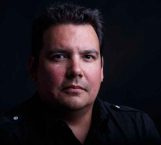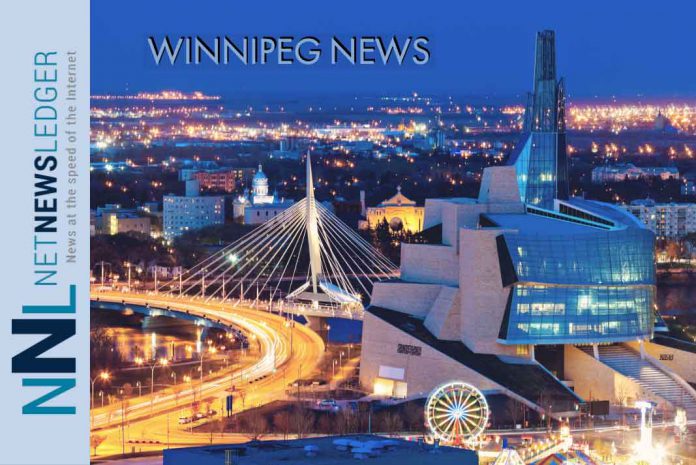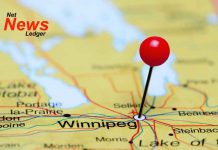To mark its 200th anniversary in 2018, the l’Université de Saint-Boniface produced a calendar that honours its history. The month of March featured a large photograph from 1938 of a priest and student actors, who were dressed as “Indians,” from a play called L’âme huronne (The Huron Soul).
The play tells of the “good” Christians struggling with witches, the devil, and Indians. It has nothing to do with actual Indigenous peoples but the fantasies and desires non-Indigenous peoples invent about Indigenous peoples. None of the actors was “Indian” – although some are named Boulet, Caron, and Sumner, which are names Indigenous peoples have today.
In fact, I know none of these actors was “Indian” because in 1938 it was illegal to wear traditional clothing in public (it wasn’t legal until 1951, for the anniversary of the Calgary Stampede).
In the calendar, there is no context, no explanation about how things have “changed,” or much else; and no real reason to “honour” this history at all.
There is just the black-and-white photograph: a stark, silent reminder of how difficult it is to have conversations about the complicated history the university shares with Indigenous peoples.

“The institution has yet to understand our complicity in the genocide of Indigenous peoples,” said university social work Prof. David Alper in the documentary Sous la Coupole (Under the Dome).
I phoned some professors to see if this is true. One tells me not to use her name, but states: “(The university) is 10 years behind all other universities in Manitoba when it comes to Indigenous initiatives.”
Another, who asked that his name not to be used, said: “I can’t talk about Indigenous anything there because there is a deep denial in our community, including the fact that many French in Manitoba are Indigenous themselves.”
Others just refuse to speak to me altogether, fearing they’ll be punished for speaking out.
Students, however, are speaking out. In 2016, the university’s Métis student committee formally requested the university recognize its complicity in residential schools. This came after a 2014 visit by Commissioner Marie Wilson of the Truth and Reconciliation Commission, which told how the university hired and trained teachers for, and governed the creation and delivery of, residential schools.
In 1912, for example, the Archbishop of St. Boniface wrote to the federal government, asking government officials to remove Indigenous children from their families as early as possible because: “How can improvement be looked for in the race if the children, when out of school, are subjected to such degenerating environment?”
In other words, the university was as much responsible as universities such as the University of Manitoba, which apologized for its role in 2011.
In response to students in 2016, then-president Gabor Csepregi stated in a letter: “The history of the minority francophone community in Manitoba is very different from that of the majority anglophone community.” He stated it was a “peaceful and respectful encounter… that gave birth to North American Nations and Métis communities.”
Csepregi is hardly objective when it comes to Indigenous peoples in universities. In 2017, he co-wrote an article called Should Canadian Indigenous Knowledge be Open to Challenge? It questioned whether Indigenous nations exist (stating “scholars have even asked if these people were truly nations”); argued that hiring Indigenous professors was problematic because some might make “false declarations”; and demanded that Indigenous knowledge be interrogated because “it is treated as so sacred it can’t be openly debated.”
These claims, by a university president, are so ignorant and void of research that I don’t know where to begin.
Despite Csepregi, students continued to demand Indigenous programming. A large part of this is because many are Indigenous – 11.5 per cent of the university’s student population. Most are self-declared Métis (93 per cent). Every single student at the university therefore works alongside, or shares space with, an Indigenous person.
In a March 2019 referendum, students voted 72 per cent that a course in Indigenous perspectives be mandatory for all university-level students. The faculty union for professors supported the students.
Now, the university has a new president, Sophie Bouffard, who had served as president of the University of Sudbury and worked at the University of Regina, both schools that have high Indigenous student populations.
“(Saint Boniface) has signed agreements to commit to the TRC calls to action and the City of Winnipeg’s Indigenous Accord,” Bouffard said, “So I’ve directed our academic senate that if we have committed to these, we should incorporate them in our planning.”
The university is developing a long-term strategic plan, to be released next year. Bouffard said it’s early in the process but admits the university has a long way to go in understanding the role the institution has played in violence against Indigenous peoples, as well as its own identity.
“It’s our job to understand where we have come from, to know where we are going as a community,” Bouffard says. “In fact, I’ve met with the Indigenous leaders like those at the L’Union Nationale Métisse, and we have an initiative in place for next year.”
She agrees images such as the one in the 2018 calendar don’t define the university today.
“We have to do better and more.”
 Niigaan Sinclair
Niigaan Sinclair
Originally appeared in the Winnipeg Free Press on November 2019. Republished with the permission of the author.
The views, opinions and positions expressed by all columnists and contributors are the author’s alone. They do not inherently or expressly reflect the views, opinions and/or positions of NetNewsLedger.







